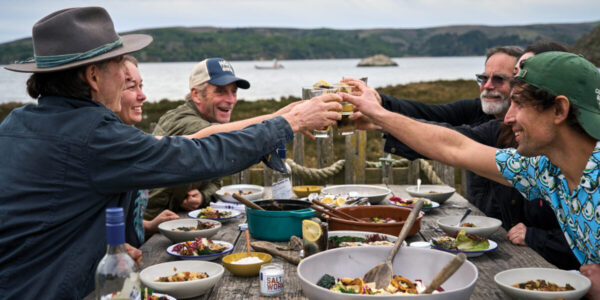
Tucson landmark: San Xavier del Bac
Marble and ceramic tile were in short supply in 18th-century New Spain. This being the Sonoran Desert, wood was just as scarce. That’s why, when it came time to build Tucson’s Mission San Xavier del Bac, artists were called in to create with pastels and brushes what they didn’t have in real goods.Near the main altar, for example, is a pastel dado that looks like real ceramic tiles. Nearby, faux marble molding crowns the walls. In the nave, a trompe l’oeil door on one wall neatly balances a real wood one opposite. Paintings of saints on the church’s plaster walls are bordered by stenciled frames that look like wood. Two of them are “hung” from the ceiling by elaborately sketched ropes. And in the choir loft, where singers sat on crude benches, fanciful chair backs are painted directly onto the plaster, as if the illusion would truly lend them support.
If the work of the 18th-century artists who pulled off these visual tricks seems more noticeable these days, it is thanks to an Lestimated $1.4-million conservation project that began in 1989 and should be completed next year, in time for the mission’s bicentennial. The project, spearheaded by a volunteer group called Patronato San Xavier, tackles both the exterior and the interior of Arizona’s landmark mission, which is still an active church for members of the Tohono O’odham Nation, whose San Xavier district boundaries match those of the parish.
Mission perceptible
San Xavier was founded in 1692 by the Jesuit missionary and explorer Eusebio Kino at what was then the Indian village of Bac. It was Kino’s Franciscan successors, though, who built the present church in the late 1700s. Historians believe that the friars used craftspeople and artists from Querétaro, Mexico, as well as local Indians, to help construct and decorate the building, which stood on the desert like a beacon. The friars ran out of money before they could finish one bell tower and decorate one of the largest rooms in the church, but the elaborate Mexican baroque exterior and vividly painted interior had the desired effect – to draw native people into the fold.
Two centuries of almost constant use, an earthquake, and several well-intentioned but poorly executed preservation projects took their toll on San Xavier. By the early 1980s, the church and the members of the Patronato decided to mount an intensive fund-raising campaign to give the building a state-of-the-art face-lift.
As it turns out, state of the art has often meant going back to ancient ways. On the exterior of the church, modern, nonporous stucco has been replaced by a centuries-old plaster recipe containing sand, lime, and juice from boiled prickly pear cactus. The new mixture lets moisture evaporate before it does damage to the church’s brick-and-stone-rubble walls.
Inside San Xavier, an international team of conservators has been working each winter since 1992. Led by Paul Schwartzbaum – chief conservator of the Solomon R. Guggenheim Museum in New York, whose résumé includes advising on the restoration of the Sistine Chapel – the conservators have been painstakingly cleaning candle smoke and dust from the garments of saints and the faces of angels, repairing water damage, and stabilizing the frescoes and sculpted surfaces, one section at a time.
But perhaps the most important aspect of the effort has been the training of members of the Tohono O’odham Nation in conservation techniques. Although some things are still in short supply out here in the Sonoran Desert, the conservators are trying to make sure that the knowledge needed to keep San Xavier shining for another two centuries is not one of them.
Mission at a glance
HISTORY: Mission founded in 1692; construction on current church 1783-1797; first restoration 1905-1908; designated a national historic landmark in 1963; Patronato San Xavier formed in 1978; latest exterior restoration began in 1989.
WHERE: Nine miles southwest of downtown Tucson. From Interstate 10 take I-19 south, then exit on San Xavier Road. Go west 2 miles.
WHEN: San Xavier is open daily. Mass is held mornings Mondays through Fridays, evenings Saturdays, more frequently on Sundays.
CONTACT: (520) 294-2624.
